Mauna Kea Stargazing Takes on the NEOWISE Comet!
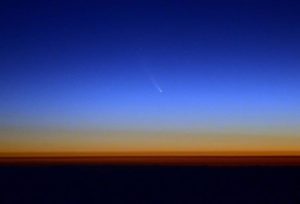
NEOWISE/ C20202 F3 Comet & Mauna Kea Stargazing
Mauna Kea Observatories
The time is 12am. Myself, Zoe (GM of Ali’i Adventures) and amateur astronomer husband Johan wake to seek out the NEOWISE Comet. We are headed to Mauna Kea to take in the spectacle, dragging our “kids” (cameras and a very large telescope called NEO -after the comet) up to join the other observatories to view the comet. Mauna Kea stargazing is an exceptional experience due to it’s low temperatures and minimal light pollution. The coffee machine grumbles loudly as we quietly but eagerly mission around the house grabbing our remaining essentials for the trip, trying to force our eyes to accept the 1.5 hrs sleep we had will just have to do.
The NEOWISE comet (a.k.a C/2020 F3) is a 3-mile-wide comet, containing materials several billion years old that was only discovered in March. It takes nearly 7,000 years to circle the sun and remains visible to us for about the rest of July 2020. The NEOWISE comet was discovered by (and subsequently named after) NASA’s Near Earth Object Wide-field Infrared Survey Explorer; a spacecraft that was originally directed to look for potential hazards to Earth and detected this comet.
It’s a clear night leaving Kona and the roads are quiet so we enjoy a pleasant drive talking through the details of the comet and what else we might be able to see, gradually gaining height as we continue over the volcanic flanks towards the Mauna Kea Visitor Center. We reach the visitor center about 2:30am. The skies remain clear but we note the movement of the trees as the wind picks up around the visitor center. We meet another bloke there adjusting his camera for the comet and spending some time at the center to acclimatize like us (we are going from sea level to just under 14,000ft in a matter of hours). This is always a stop on the Mauna Kea stargazing trips where people sip hot chocolate and start to take in constellations overhead. The temperature has dropped to 51 F at the center (83 F in Kona when we left) so we pack on some thermals in the parking lot, knowing it will be significantly colder up top, before continuing up Mauna Kea towards the observatories. In my naïve (though growing) knowledge of all things astronomical, I overhear Johan and the gent exchanging thoughts that the comet should be most visible around 4am, rising from the North East. We close the doors of our little Kia Soul and head up to join the explorers of the universe perched on the summit.
If you are reading this please note the importance of taking a 4×4 on the road in between the visitor center and the observatories. It is not law to have a 4×4 to go up but highly recommended. The road itself is easily passable in a low, non 4×4 car but it is the descent and the strain on the brakes that presents a hazard so a 4×4 will allow you to put the car in low range and thus put the engine more to work rather than riding the breaks. Mauna Kea stargazing trips will take you up to the observatories in 4x4s. Perhaps it is our time living in remote lands with rough terrain that made us feel like undiscovered rally drivers but we continued up in Johan’s Kia Soul (this is at least a manual and thus gives control over the low gears). We make it to the observatories at about 3:15am with a successful ascent in the boxy Soul.
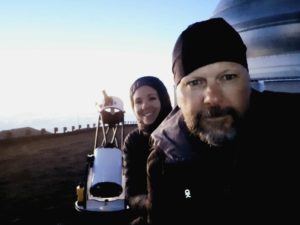
It’s now time to get to work. Johan readies the telescope trying to quickly re-calibrate the view finder after a bumpy ride up and I whip out the head lamps switching them straight into red light mode. (For those who don’t know your eyes need about 20 minutes to adjust to the darkness again after being exposed to white light. This does not happen with red light.) We spot a few other people up there also having made the early rise for the comet. A couple of people with the University of Hawaii Telescope, perch on its’ outer deck, navigating their 6 cameras under their red lights as well.

The Kids
It’s 31 degrees now (before wind chill) so I whip out the big jackets, hats and gloves. Luckily, I have brought my sleeping bag with me so I throw it over my head and run around underneath the observatories like a blob, taking in different angles.

Gemini North, with a blob (Zoe) and Neo.
Johan takes a moment to focus the telescope on Saturn. The first sighting of our morning where we excitedly again view the rings of Saturn. This is one of my favorite viewings through the telescope. While waiting for that special window to hopefully view the comet we filter through the night sky, taking in the Ring Nebula, Venus, Pleiades and other clusters and objects; frequently scouted out on Mauna Kea stargazing mornings and evening.
The time is 04:10am now. Time to pay attention. We stand next to the mounted camera and Neo in the expected direction. Johan has the camera on a remote ready for long exposure shots. I clutch a pair of high powered binoculars through very cold hands, ready for that first glimpse…. There! Through a gaze of averted vision towards the horizon I see an extremely faint, cloudy…something. Johan snaps the lens and I raise the binos…there is definitely something there. The 20 seconds of the long exposure shot on the camera pass and the viewing screen of the camera lights up. The NEOWISE comet is perfectly clear. We excitedly play musical chairs through the different instruments viewing the comet as its’ clarity becomes even better. Soon it is completely visible with the naked eye. We fixate on the comet for the next 30 minutes or so as it starts to climb higher in the sky and the morning colors of reds and greens push through the horizon.
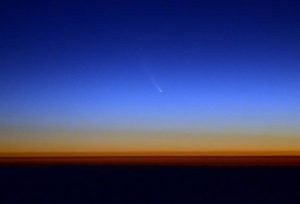
NEOWISE Comet
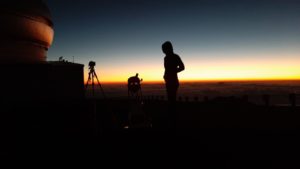
Zoe and the kids. A moment of reflection of Comet Neowise.
A few more people join up top Mauna Kea, there to watch the famous sunrise. People run around holding each other for warmth and pouring cups of hot coffee waiting for the sun to break. The fiery star eventually pierces the cloudy horizon and so we take our que to load up the equipment and head back down. We have packed all the goodies to cook a decadent breakfast so we decide to head down and towards the Mauna Kea Recreation Park to prepare a scrumptious breakfast and thaw in the sun. Nothing beats a hot breakfast after a Mauna Kea stargazing trip. There is a rumbling followed by a silence on our back left and we spin around to spot Gemini North’s windows opening. The door slides down releasing curiosity to the 8.1 meter telescope inside. Soon the KECK twins do the same followed by UKIRT. NASA follows suit and puts on a show sending a laser into the darkness towards the direction of Pleiades. We count a total of 7 observatories transparently active and hop from one to the other photographing them, trying to get a glimpse of the legendary telescopes inside their dome homes. It is spectacular. We run around underneath the majesty of the space giants. Johan yells “Quick Zoe get over here, UKIRT’s doors are opening!”. A few moments later I scream back to him (in front of a few pro astronomers, working with one of the telescopes, “Bloody hell! Gemini is rotating…I’m getting this on VIDEO!!” . (Thanks for your patience pro astronomers should you ever read this).
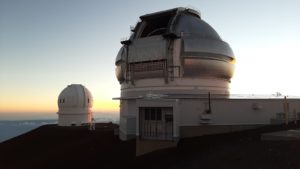
Gemini North
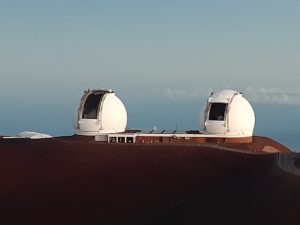
KECK 1 and 2 (Look closely for size perspective; those are cars parked under KECK 1)
We take it very easy on the drive down from Mauna Kea, pulling over to let the workers of the observatories past on their missions back down to base, and simply staying in low gear. Slowly but surely the sun rises higher and starts to heat up the foothills of Mauna Kea just in time for us to brew some Kona coffee and cook breaky, reminiscing on such a tremendous morning and successful observation of the NEOWISE comet.
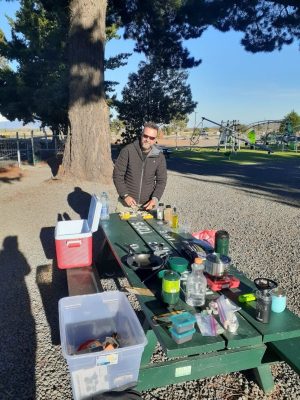
Johan cooking breakfast…and continuing to do all the work while Zoe prances around taking photos having done her 1 task of brewing coffee.
